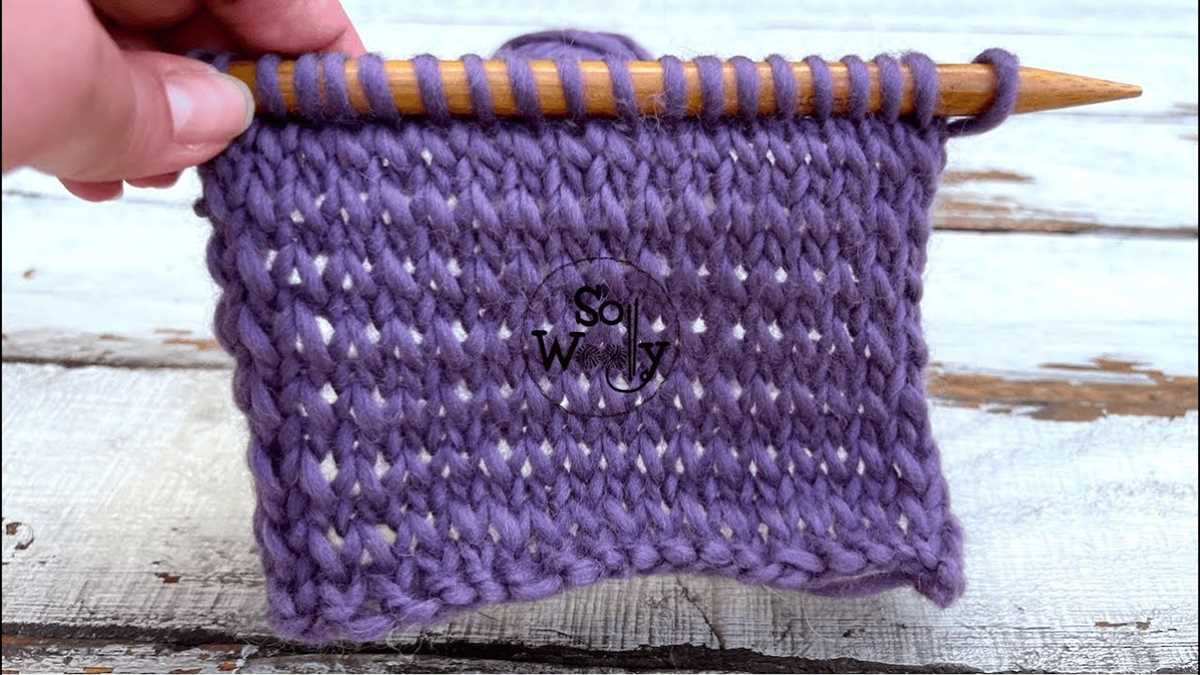
Knitting is a popular craft that has been enjoyed by people all over the world for centuries. It is not only a creative outlet but also a relaxing and therapeutic activity. If you are new to knitting and looking for beginner-friendly patterns, you are in the right place. In this article, we will explore some easy knitting patterns that are perfect for beginners.
One of the simplest knitting patterns for beginners is the garter stitch scarf. This pattern involves knitting every row, so you won’t need to worry about purling. The garter stitch creates a tightly knit fabric, making it a great choice for a cozy and warm scarf. You can choose any color or type of yarn to make your scarf unique.
Another beginner-friendly pattern is the basic hat. This pattern is great for learning how to knit in the round. You can start with a simple beanie hat or try something more adventurous like a slouchy hat. Just make sure to choose a yarn that is soft and warm, so you can stay snug and stylish during the colder months.
If you are feeling more adventurous, you can try knitting a simple baby blanket. This pattern usually involves basic stitches like knit and purl, and it’s a great way to practice your tension and stitch consistency. Plus, there’s nothing more rewarding than gifting a handmade blanket to a little one.
Whether you are looking to create your first project or expand your knitting skills, these beginner-friendly patterns are the perfect place to start. With a little practice and patience, you will be able to create beautiful and functional knitted items in no time.
Basic Knitting Stitches for Beginners
When it comes to knitting for beginners, mastering the basic stitches is key. These simple stitches form the foundation of most knitting projects and are essential for creating various patterns and designs.
1. Knit Stitch
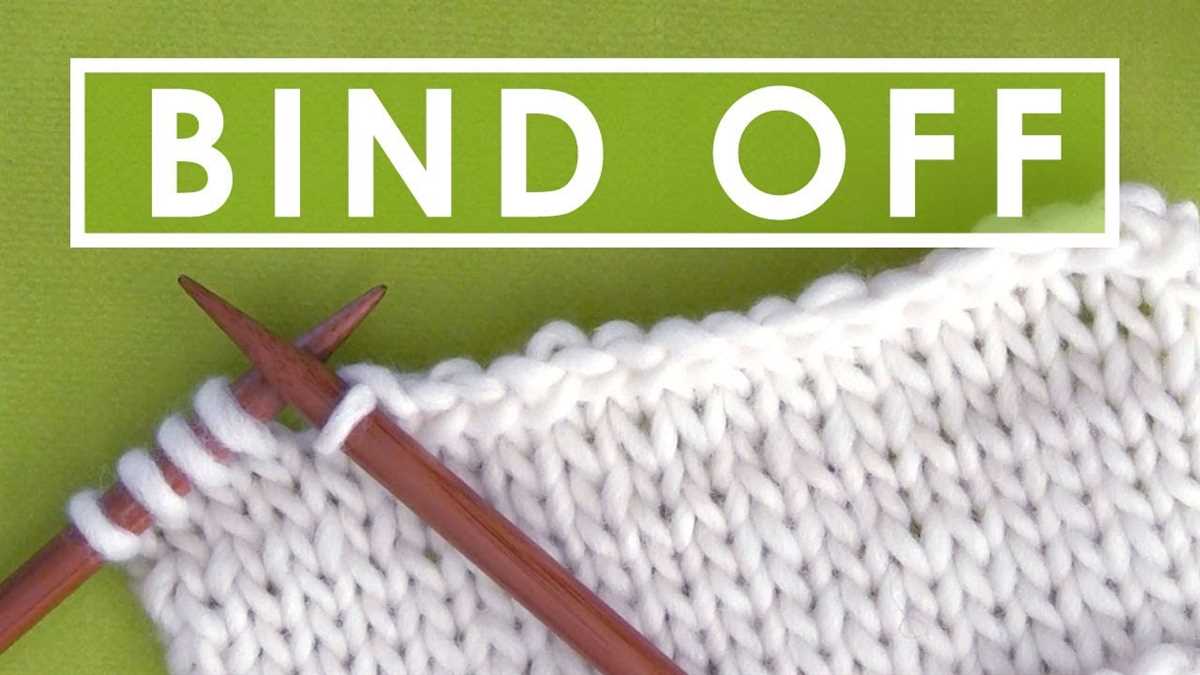
The knit stitch is the most basic and commonly used stitch in knitting. It creates a smooth, v-shaped texture on the fabric and is often used for making simple scarves, blankets, and sweaters. To knit, insert the right needle into the first stitch on the left needle from left to right, then wrap the yarn around the right needle and pull it through the stitch, sliding it off the left needle.
2. Purl Stitch
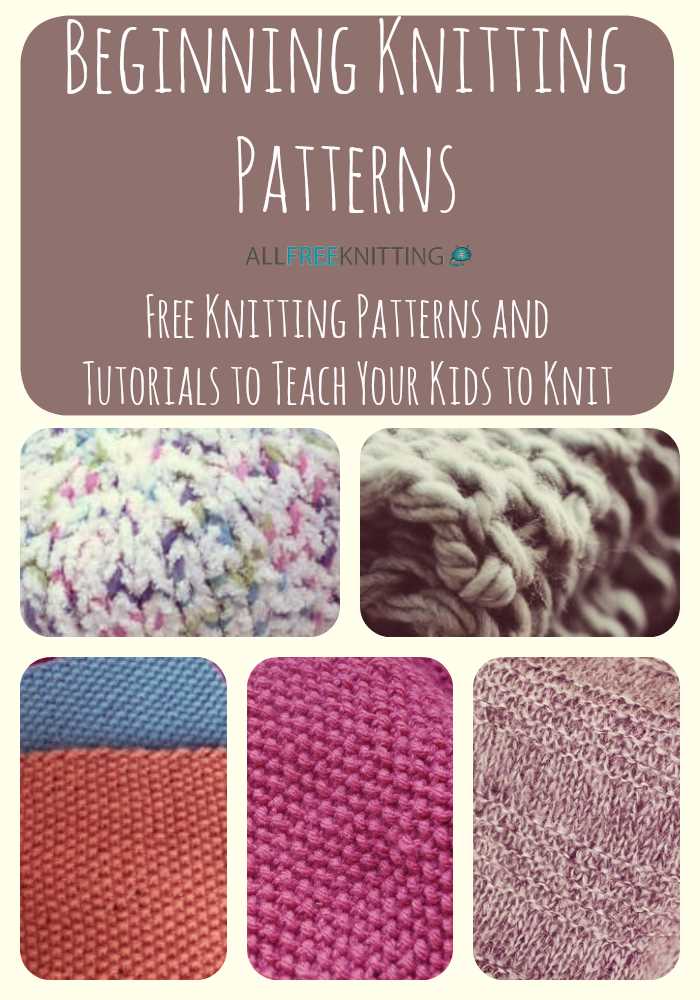
The purl stitch is another fundamental stitch that creates a bumpy, horizontal texture on the fabric. It is often used in combination with the knit stitch to create different patterns and add texture to the knitting project. To purl, insert the right needle into the first stitch on the left needle from right to left, wrap the yarn around the right needle and pull it through the stitch, sliding it off the left needle.
3. Stockinette Stitch
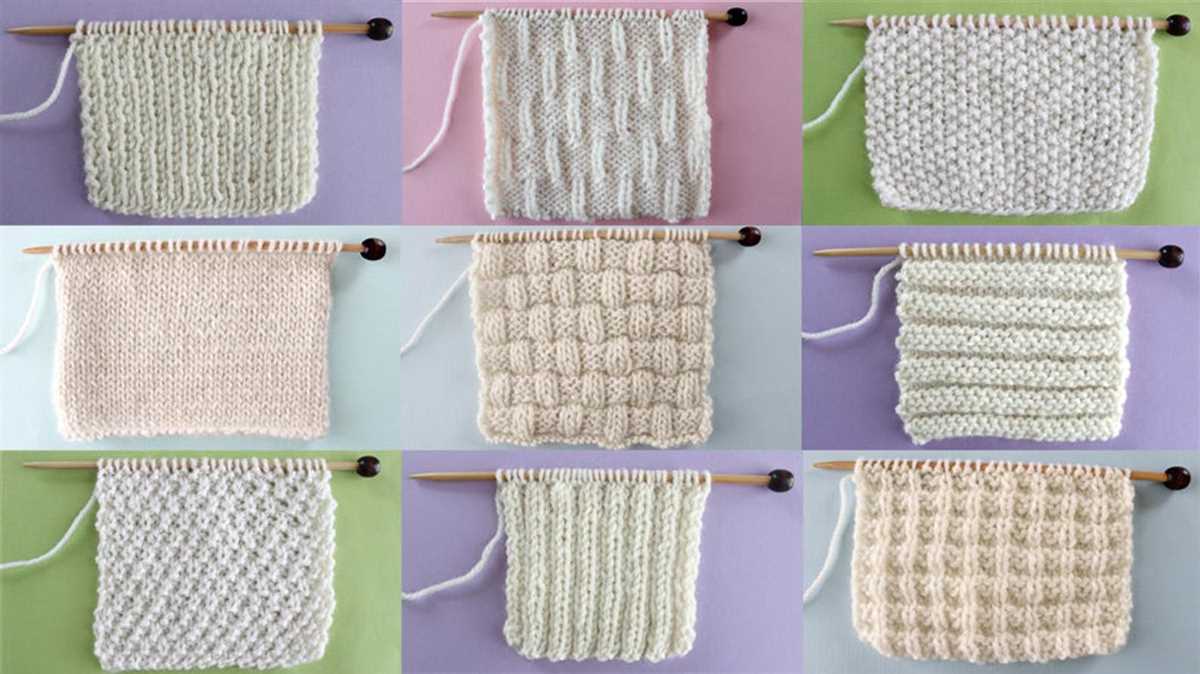
The stockinette stitch is created by alternating knit and purl rows. It produces a smooth, flat fabric on the right side and a bumpy texture on the wrong side. This stitch is commonly used for making sweaters and other garments. To create the stockinette stitch, knit one row and purl one row, repeating this pattern until the desired length is reached.
As a beginner, practicing these basic knitting stitches will help you build the foundation for more complex patterns and techniques. Remember to take your time and stay patient as you learn. With practice, you’ll soon be able to tackle more advanced knitting projects with ease.
Choosing the Right Yarn and Needles
When starting your knitting journey as a beginner, it’s important to choose the right yarn and needles for your project. The materials you use can greatly affect the outcome of your knitting, so it’s worth spending some time to make the right choices.
Yarn
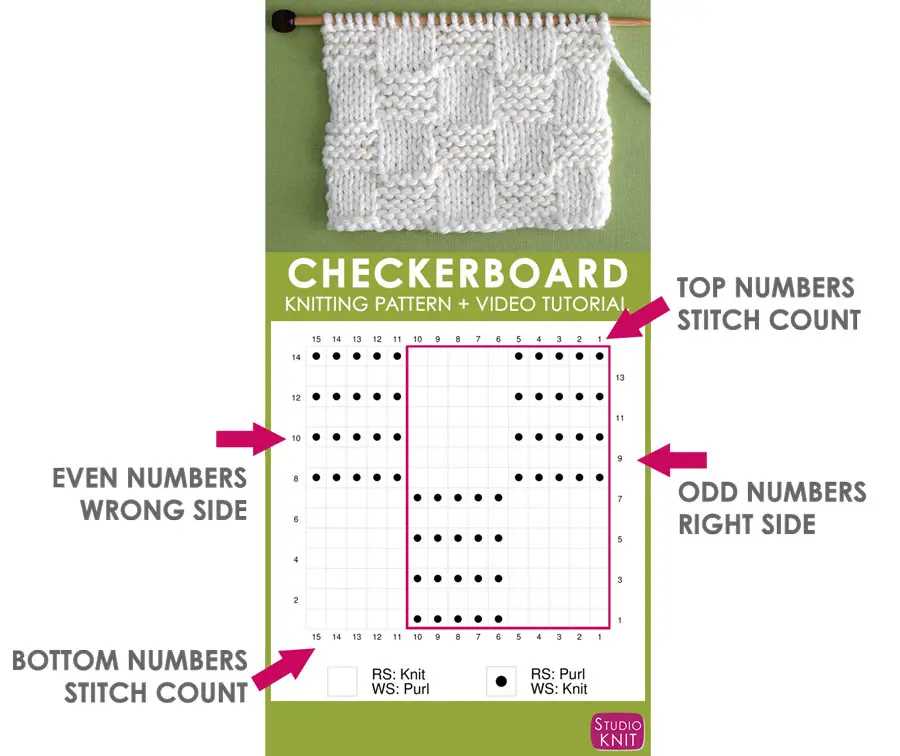
The first thing to consider when choosing yarn is the fiber content. Different fibers have different qualities, such as warmth, durability, and softness. Common yarn fibers include wool, cotton, acrylic, and blends. For beginners, it’s often recommended to start with a medium-weight yarn, such as a worsted or aran weight. These yarns are versatile and easier to work with compared to finer or chunky yarns.
Another factor to consider is the color and texture of the yarn. Think about the final look you want to achieve with your project and choose a yarn that matches your vision. Solid colors are easier to work with as a beginner, as they show stitch patterns more clearly. Textured yarns, such as boucle or eyelash, can add interesting effects to your knitting but may be more challenging to work with.
Needles
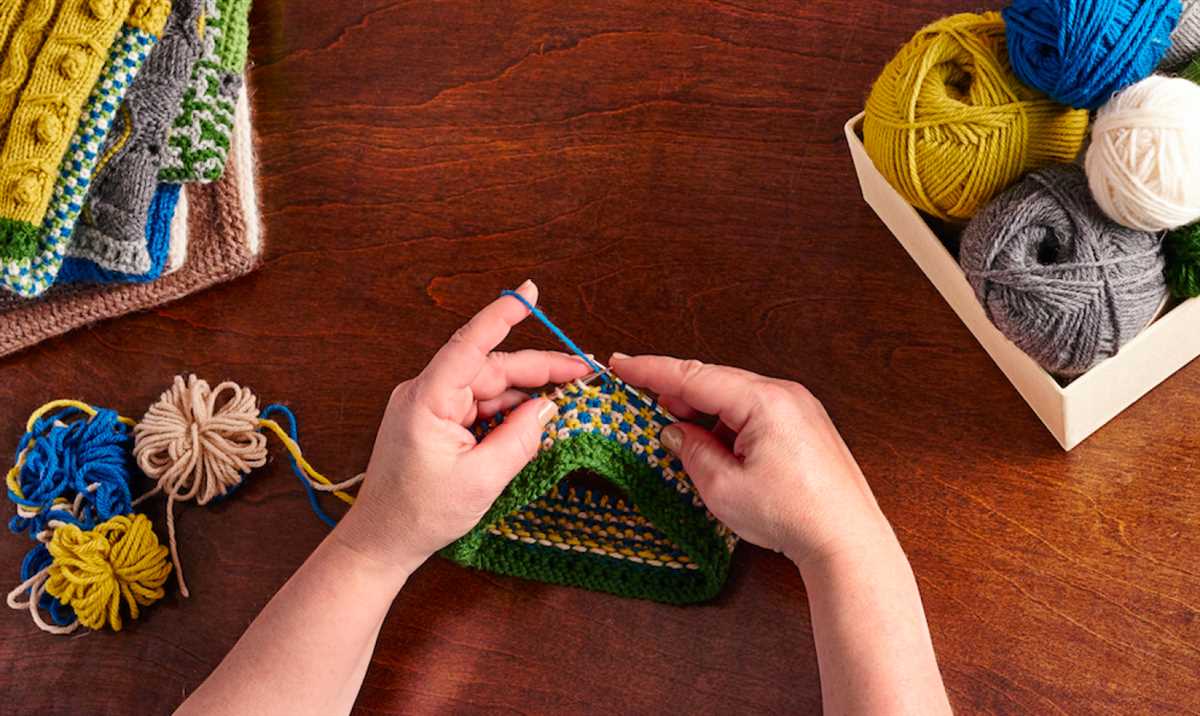
Choosing the right needles is also essential for a successful knitting experience. The size of the needles will depend on the thickness of your yarn and the tension you want to achieve. Most yarn labels will recommend a needle size range, so it’s a good starting point. As a beginner, it’s generally easier to work with medium-sized needles, such as US size 7-9 (4.5-5.5mm).
The material of the needles is also a consideration. Common needle materials include metal, wood, and plastic. Metal needles are smooth and durable, but they can be slippery. Wood and bamboo needles have a natural warmth and grip, making them suitable for beginners. Plastic needles are lightweight and inexpensive but may not be as durable as other materials.
- Consider the fiber content and weight of the yarn when choosing the right materials for your knitting project.
- Keep in mind the color and texture of the yarn to achieve the desired final look.
- Choose the appropriate needle size based on the yarn thickness and tension you want to achieve.
- Consider the material of the needles for comfort and ease of use.
Simple Knitting Projects for Beginners
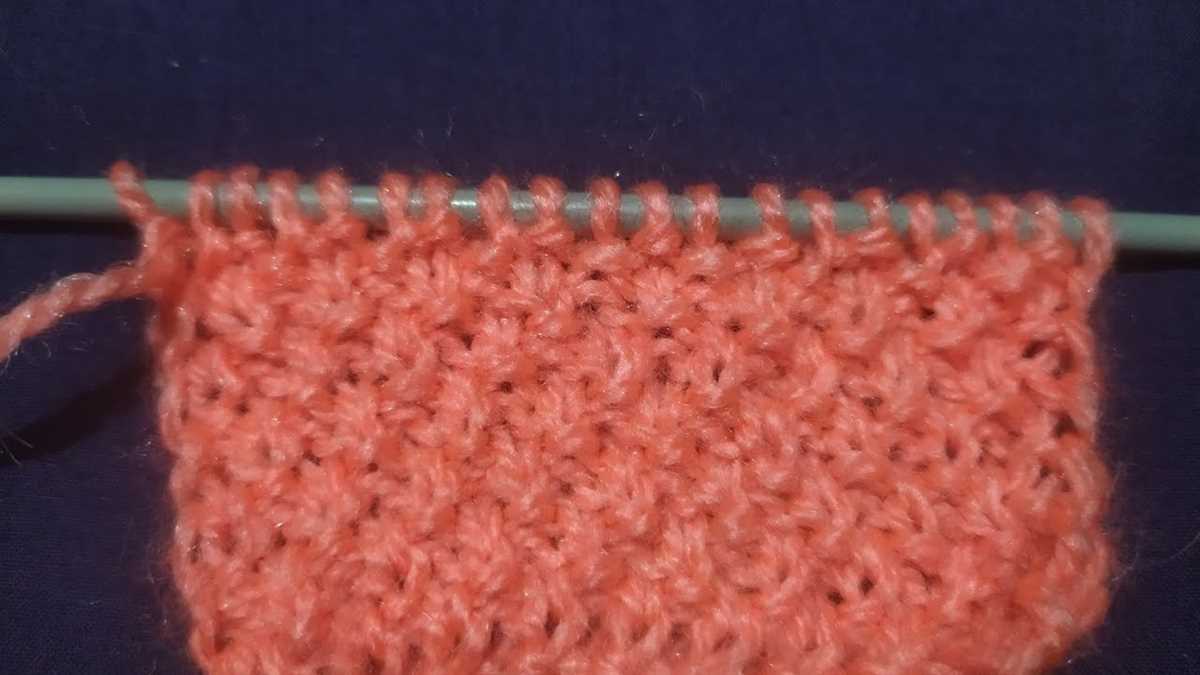
Knitting can be a relaxing and enjoyable hobby, but it can also be intimidating for beginners. However, there are many simple knitting projects that are perfect for those just starting out. These projects are easy to follow and don’t require advanced knitting skills, making them perfect for beginners to practice and learn the basics of knitting.
1. Scarf: Knitting a scarf is a classic project for beginners. It involves basic knitting stitches and allows you to practice your tension and stitch consistency. You can choose to knit a simple garter stitch scarf or experiment with different stitch patterns.
2. Dishcloth: A dishcloth is another great project for beginners. It is small, quick to knit, and practical. Knitting a dishcloth allows you to practice different stitch patterns and techniques while creating something useful for your kitchen.
3. Hat: Knitting a hat is a step up from scarves and dishcloths but still a manageable project for beginners. You can start with a basic beanie or explore different hat patterns. Hats are a great way to learn shaping, working in the round, and adding simple embellishments.
- 4. Headband: A headband is a smaller project that can be completed quickly. It is perfect for beginners who want to practice knitting in the round and experiment with different stitch patterns and textures.
- 5. Baby blanket: If you’re feeling more ambitious, knitting a baby blanket is a great project. It allows you to practice larger-scale knitting and learn basic lace or colorwork techniques. Plus, baby blankets make great gifts!
- 6. Coffee cozy: Knitting a coffee cozy is a fun and practical project. It is small, quick to knit, and allows you to practice different stitch patterns. Plus, it’s a great way to keep your coffee warm and add a personal touch to your morning routine.
In conclusion, there are plenty of simple knitting projects for beginners to try. Whether you choose to make a scarf, dishcloth, hat, headband, baby blanket, or coffee cozy, these projects will help you build your knitting skills and create something beautiful or useful in the process.
Knitting Scarves for Beginners
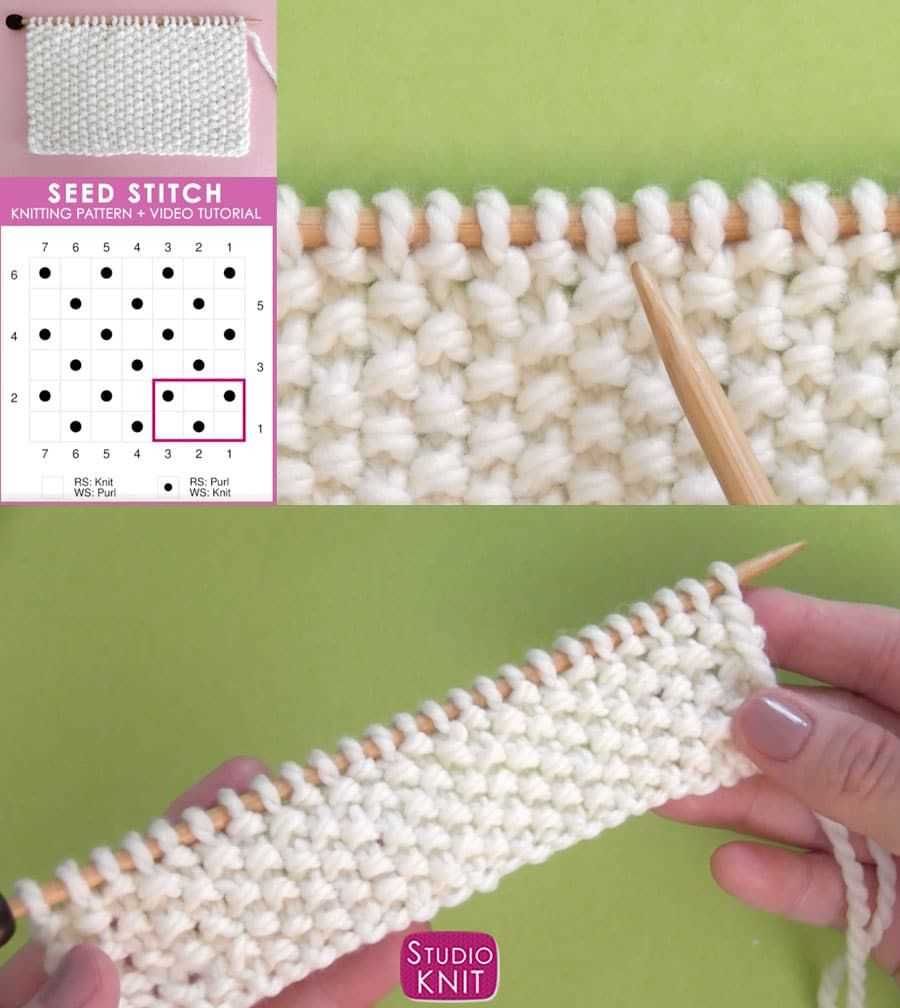
If you’re new to knitting and looking for a project to start with, scarves are a perfect choice. Scarves are simple and versatile, allowing you to practice basic knitting techniques while creating a stylish and functional accessory. With just a few basic stitches, you can create beautiful scarves that are perfect for keeping warm during the colder months or adding a pop of color to your outfit.
One of the easiest scarf patterns for beginners is the garter stitch scarf. This pattern uses just one stitch, the knit stitch, making it perfect for learning the basics of knitting. To create a garter stitch scarf, simply knit every row until the scarf reaches your desired length. You can use any type of yarn and needles for this pattern, making it a flexible option for beginners.
If you’re looking to add some texture to your scarf, the seed stitch pattern is a great choice. This pattern alternates between knitting and purling stitches, creating a bumpy texture that looks impressive but is actually quite simple to do. With just a little bit of practice, you can create a beautiful seed stitch scarf that will be sure to impress.
Another popular pattern for beginners is the ribbed scarf. This pattern creates a stretchy and reversible scarf that is perfect for colder weather. It uses a combination of knit and purl stitches to create a ribbed effect, giving the scarf some added interest. The ribbed scarf pattern is a great way to practice switching between knit and purl stitches and can be easily customized to your desired width and length.
- Garter stitch scarf
- Seed stitch scarf
- Ribbed scarf
Whether you’re looking for a simple and quick project or something with a bit more texture, there are plenty of scarf patterns that are perfect for beginners. Start with the basic stitches and you’ll be surprised at how quickly you can create a beautiful and cozy scarf to keep you warm all winter long.
Knitting Hats for Beginners
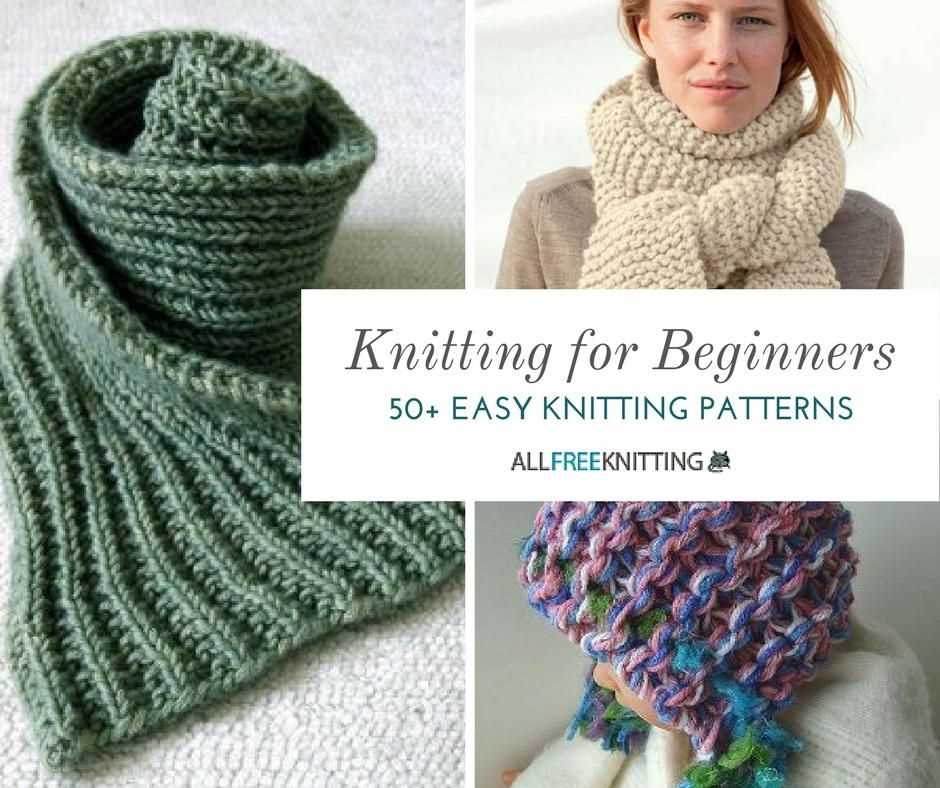
If you’re new to knitting and looking for a beginner-friendly project, knitting hats can be a great place to start. Hats are relatively quick to knit and can be a practical and stylish accessory for any season. Whether you’re knitting for yourself, a family member, or a friend, there are plenty of simple and enjoyable hat patterns available for beginners.
Choosing the Right Yarn
Before you begin knitting your hat, it’s important to choose the right yarn for your project. As a beginner, it’s best to select a soft and easy-to-work-with yarn, such as a medium-weight acrylic or wool blend. These types of yarns are more forgiving and will make the knitting process smoother. Additionally, consider the color and texture of the yarn to ensure that it matches your desired hat style.
Simple Hat Patterns
When it comes to beginner hat patterns, simplicity is key. Look for patterns that use basic knitting stitches, such as garter stitch or stockinette stitch. A basic beanie or ribbed hat pattern is often a good choice for beginners, as they are easy to follow and provide a solid foundation for future knitting projects. You can also experiment with different brim styles, such as rolled brims or folded cuffs, to add a personal touch to your hats.
Tips for Success
As a beginner knitter, it’s important to take your time and practice patience. Start with smaller projects, such as baby hats or chunky yarn hats, to build your skills and confidence. Pay attention to tension, as loose or tight stitches can affect the final fit of your hat. Don’t be afraid to ask for help or seek out online tutorials if you encounter difficulties along the way.
With a little practice and determination, you’ll soon be able to knit beautiful hats for yourself and your loved ones. Enjoy the process of learning and creating, and don’t be afraid to experiment with different patterns and techniques to develop your own unique style.
Knitting Socks for Beginners
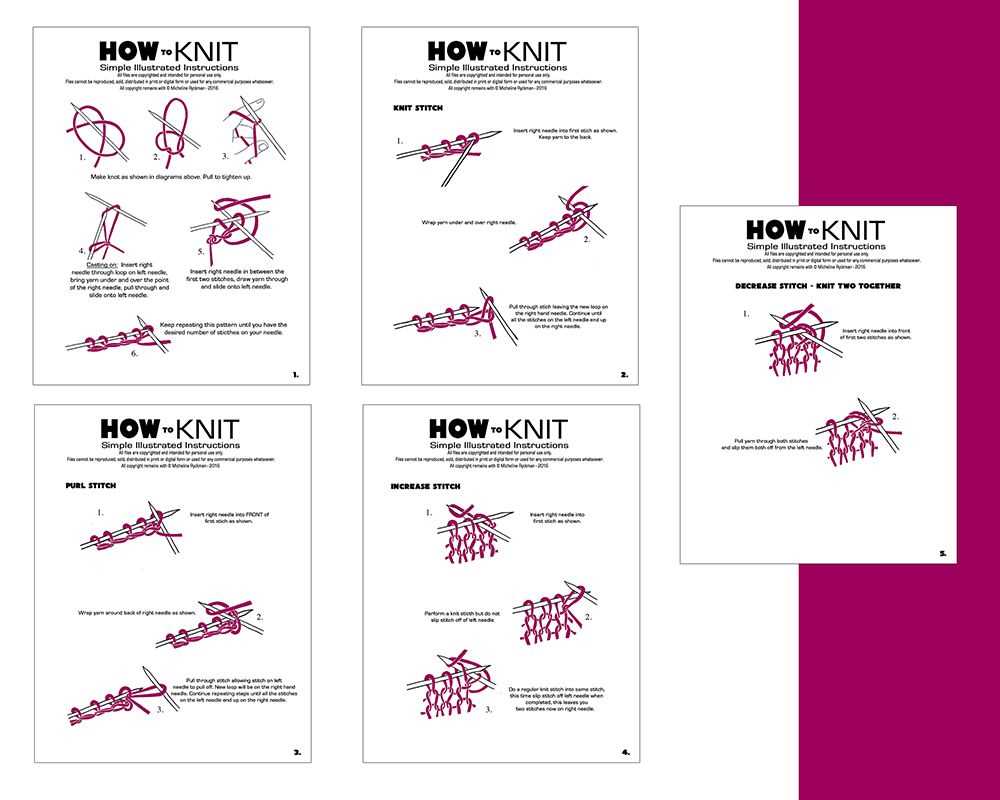
Knitting socks can seem like an intimidating project, especially for beginners. However, with the right pattern and some basic knitting skills, you can easily create cozy and comfortable socks to keep your feet warm during the colder months.
When starting out with knitting socks, it’s important to choose a pattern that is specifically designed for beginners. Look for patterns that use simple stitches and techniques, and provide clear instructions for each step. This will help you build confidence as you progress through the project.
The materials you will need:
- Yarn: Choose a soft and durable yarn that is suitable for socks. Opt for a medium-weight yarn that is easy to work with.
- Needles: Use a set of double-pointed needles or a circular needle, depending on your preferences. Make sure to choose the appropriate size needles according to the yarn weight.
- Tape measure: This will be useful for measuring your foot and determining the size of the sock.
- Tapestry needle: You will need this for weaving in the ends of the yarn.
Step-by-step instructions:
- Begin by casting on the required number of stitches onto your needles. This will vary depending on the size of the sock and the gauge of your yarn.
- Work the ribbing for the cuff of the sock. This is usually done in a knit 1, purl 1 pattern to create an elastic and snug cuff.
- Continue knitting the body of the sock in the desired stitch pattern. This can be as simple as knitting every round or incorporating more complex stitch patterns.
- Follow the pattern instructions for shaping the heel and toe of the sock. This may involve knitting short rows or decreasing stitches to create a fitted shape.
- Once you have completed the main body of the sock, bind off the stitches and weave in any loose ends.
- Repeat the process to create the second sock, making sure to match the measurements and stitch count of the first sock.
Remember, knitting socks is a craft that requires practice and patience. Don’t be discouraged if your first pair doesn’t turn out perfectly. With each sock you knit, you will improve your skills and eventually create beautiful socks that fit perfectly.
Knitting Blankets for Beginners
When it comes to knitting projects, blankets are a great option for beginners. They are relatively simple to make and can be a great way to practice different knitting techniques. Whether you are looking to make a cozy throw for your living room or a baby blanket for a loved one, there are many beginner-friendly patterns available.
One popular pattern for beginners is the basic garter stitch blanket. This pattern involves knitting every row, which makes it an easy stitch for beginners to learn. You can choose to use a single color yarn for a simple look, or experiment with different colors to create a striped or color-blocked effect.
If you’re looking to try something a little more challenging, you can consider making a blanket with a different stitch pattern, such as the seed stitch or the moss stitch. These stitches involve alternating between knits and purls, which adds texture and interest to the finished blanket. They are still relatively simple to master, making them great options for beginners.
When choosing yarn for your blanket, it’s important to consider the level of softness and warmth you desire. Acrylic yarn is a popular choice for beginners as it is affordable and easy to care for. However, if you’re looking for a luxurious feel, you might consider using a merino wool or alpaca blend yarn.
Overall, knitting blankets for beginners can be a rewarding and enjoyable project. With a little practice and patience, you can create a cozy and beautiful blanket that will keep you or your loved ones warm for years to come.
Knitting Sweaters for Beginners
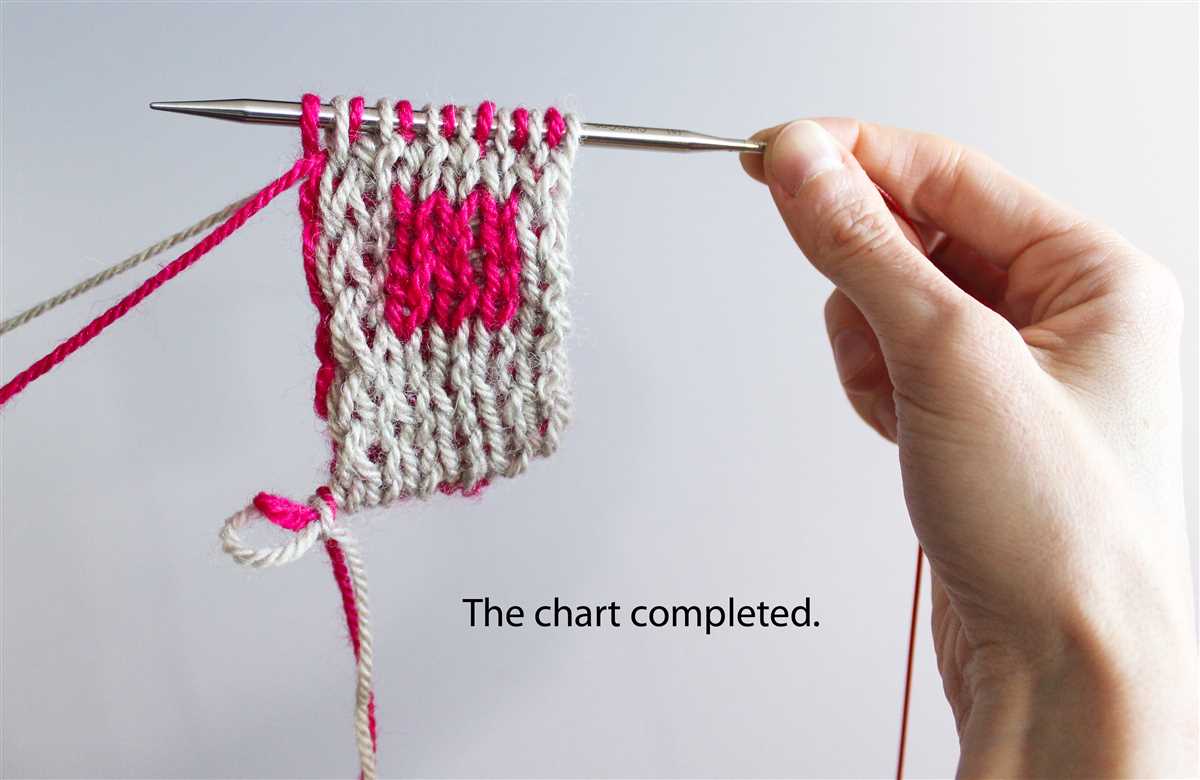
Knitting sweaters can be a fun and rewarding project for beginners. While it may seem daunting at first, with the right pattern and techniques, you can create beautiful and cozy sweaters that you can be proud of.
When starting out, it’s important to choose a pattern that is specifically designed for beginners. Look for patterns that use simple stitches and minimal shaping. This will make the knitting process easier and more enjoyable. Additionally, opt for patterns with clear instructions and diagrams to help you understand each step.
Choosing the Right Yarn
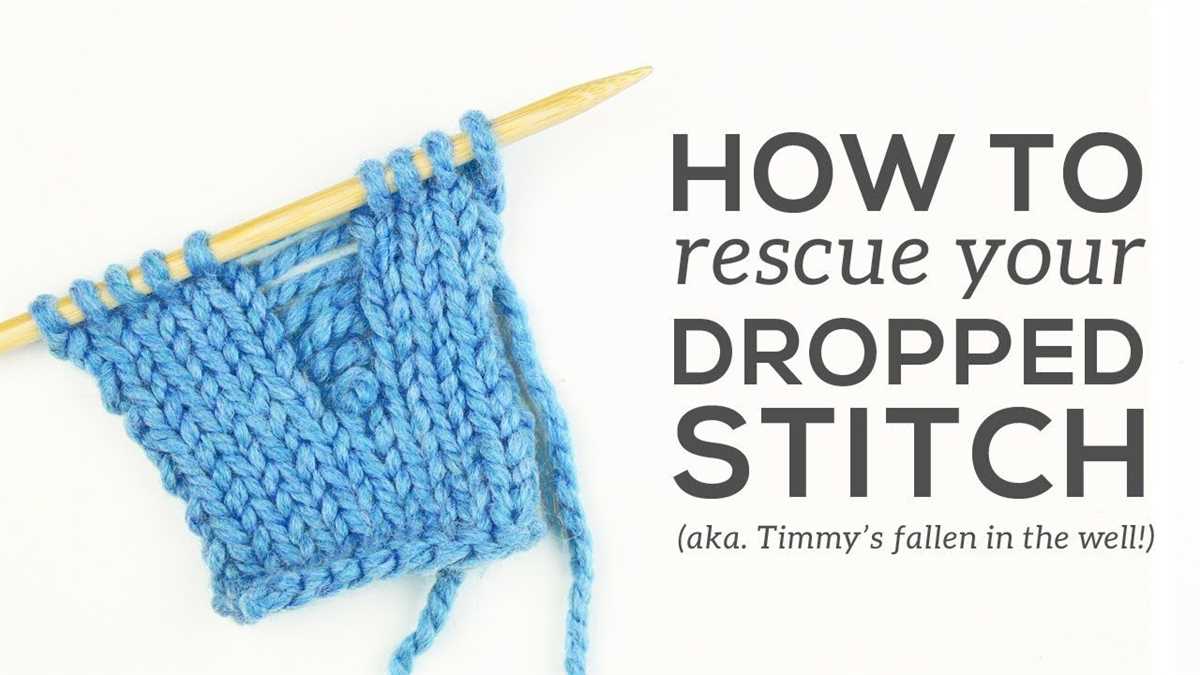
Choosing the right yarn is crucial when knitting sweaters. For beginners, it’s best to start with a medium-weight yarn that is easy to work with. Look for yarns that have a smooth texture and good stitch definition. Acrylic and wool blends are great options for beginners as they are affordable and forgiving.
Additionally, consider the color and fiber content of the yarn. Opt for colors that you love and that will complement your wardrobe. When it comes to fiber, consider your comfort and any potential allergies. Popular options include acrylic, wool, and cotton blends.
Essential Techniques
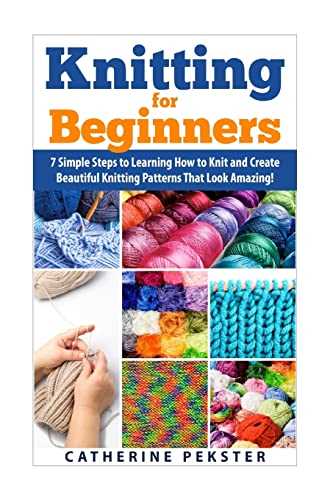
Before diving into knitting sweaters, it’s important to familiarize yourself with some essential techniques. These include casting on, knitting and purling, increasing and decreasing stitches, and seaming. Practice these techniques on smaller projects, such as scarves or hats, before attempting a sweater.
- Casting on: This is the process of getting your stitches onto the knitting needles before you start knitting.
- Knitting and purling: These are the basic stitches that you will use to create the fabric of your sweater.
- Increasing and decreasing stitches: These techniques are used to shape your sweater, such as creating sleeves or shaping the waist.
- Seaming: This is the process of sewing together pieces of your sweater to create the finished garment.
Don’t be afraid to make mistakes and practice your skills along the way. Knitting sweaters can be a challenging but rewarding endeavor, and with each project, you will learn and improve your skills. So grab your knitting needles, choose a beginner-friendly pattern, and get started on your first sweater!
Knitting Baby Clothes for Beginners
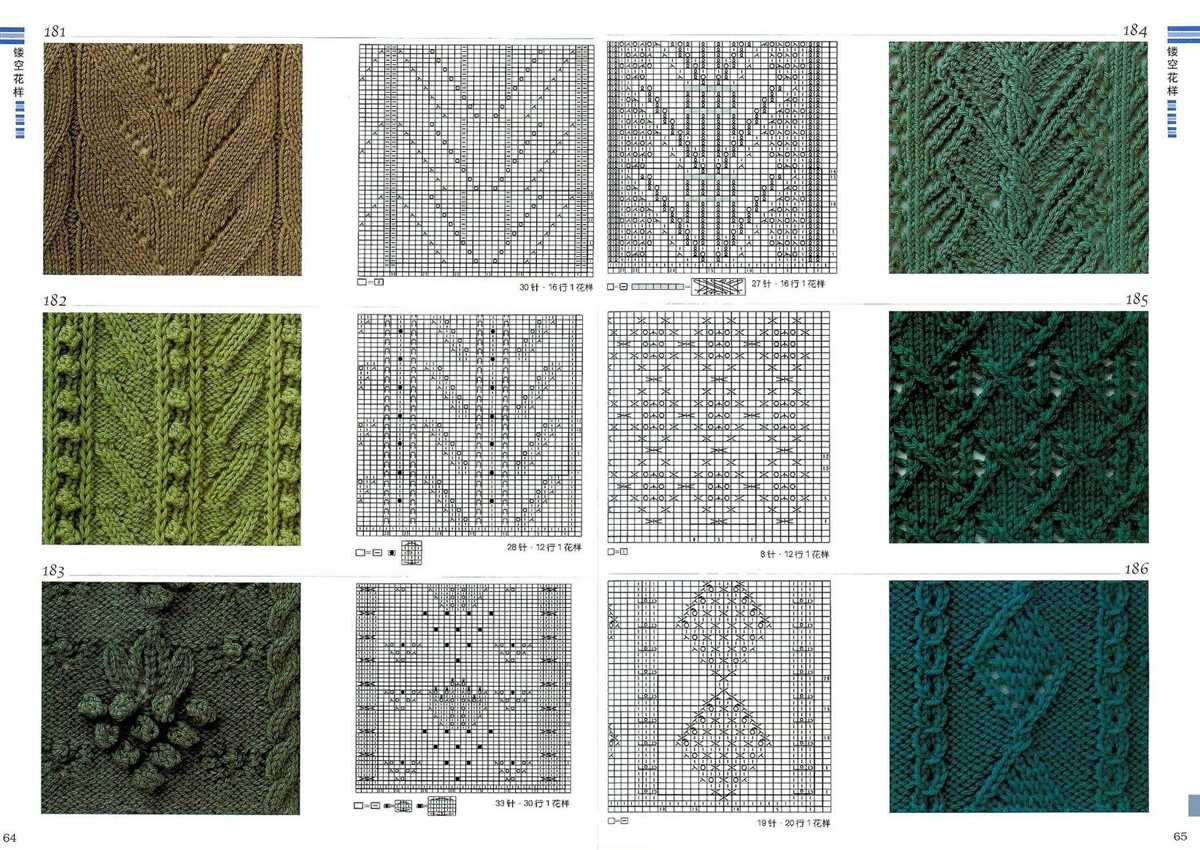
Knitting baby clothes can be a rewarding and enjoyable project for beginners. Not only will you be able to create adorable garments for the little ones, but you’ll also get to practice and develop your knitting skills along the way.
Choosing the Right Patterns: When starting out, it’s important to select knitting patterns that are specifically designed for beginners. Look for patterns that are labeled as “easy” or “beginner-friendly” to ensure that you won’t feel overwhelmed by complex instructions or techniques. Simple patterns such as basic baby hats, booties, or blankets are great projects to start with.
Selecting the Right Yarn: When knitting baby clothes, it’s crucial to choose yarn that is soft, gentle, and hypoallergenic. Babies have sensitive skin, so it’s best to avoid using yarns that contain wool or other potential irritants. Look for baby-friendly yarn options made from cotton, bamboo, or acrylic. These materials are not only gentle on the skin but are also easy to care for.
Start with Small Projects: As a beginner, it’s best to start with small and quick projects. Baby clothes are perfect in this regard since they are generally smaller in size and require less time and yarn to complete. By starting with smaller projects like baby booties or hats, you can gain confidence and progress to more complex patterns as you become more comfortable with knitting techniques.
Join Knitting Communities: Joining online knitting communities or local knitting groups can provide valuable support and guidance as you venture into knitting baby clothes. These communities can offer helpful advice, share tips, and provide inspiration for your projects. Additionally, being part of a knitting community can give you the opportunity to connect with other knitters who share your passion for creating handmade baby clothes.
The Joy of Handmade Baby Clothes: One of the joys of knitting baby clothes is the pleasure of seeing your little creations being worn and cherished by adorable little ones. Handmade baby clothes not only provide warmth and comfort but also become cherished keepsakes that can be passed down through generations. Knitting baby clothes allows you to create something special while also developing your skills and enjoying the therapeutic aspect of this timeless craft.
Knitting Toys for Beginners
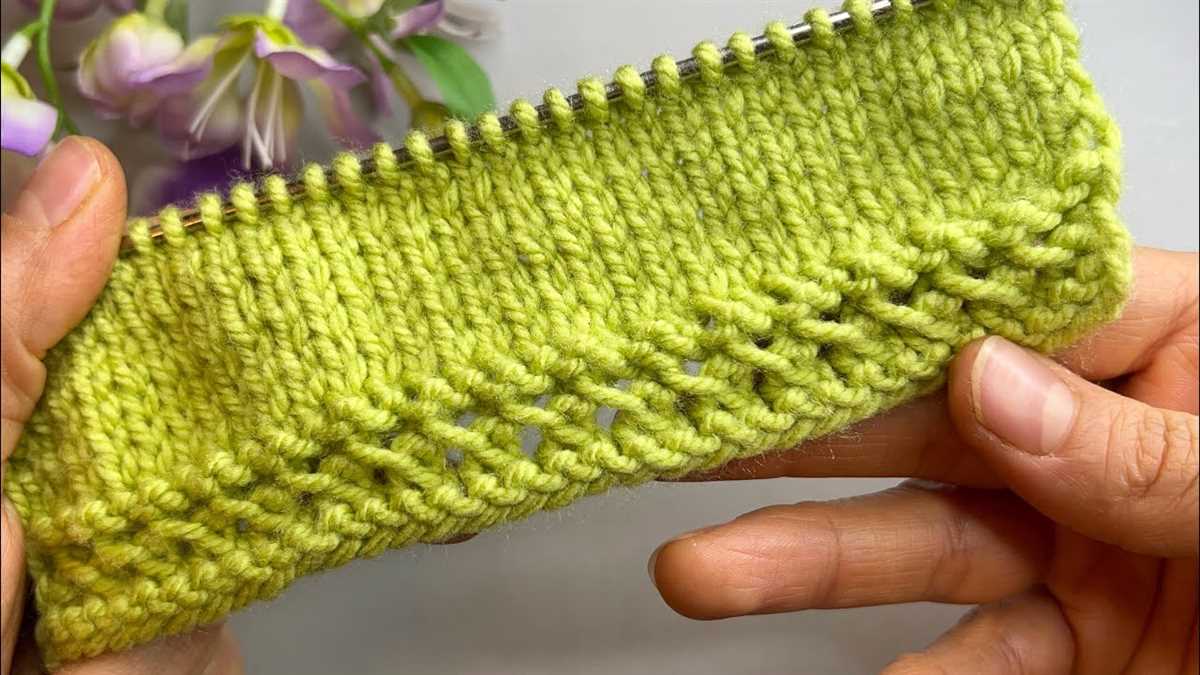
In the world of knitting, making toys can be a rewarding and enjoyable project for beginners. Knitting toys allows you to create adorable and cuddly creatures that can be cherished for years to come. With a few basic knitting skills and some patience, you can create unique toys that are sure to bring joy to both children and adults alike.
When starting out with knitting toys, it’s best to choose simple patterns that are specifically designed for beginners. These patterns often use basic stitches and techniques, making them easier to follow and perfect for honing your knitting skills. Look for patterns that include detailed step-by-step instructions, clear diagrams, and helpful tips to guide you through the process.
Materials needed for knitting toys:
- Yarn: Choose a soft and durable yarn suitable for toys. Acrylic or cotton yarns are popular choices and come in a wide variety of colors.
- Knitting Needles: Use needles that are appropriate for the yarn you have chosen. Circular or double-pointed needles may be required for certain patterns.
- Stuffing: You will need stuffing material, such as polyester fiberfill, to give your toys their shape and make them soft and huggable.
- Embroidery Thread: Embroidery thread or yarn can be used to add facial features and other details to your toys.
- Toy Safety Eyes and Noses: If desired, you can use plastic safety eyes and noses to give your toys a more finished look. These can be purchased at craft stores or online.
As you gain confidence and experience, you can gradually challenge yourself with more complex toy patterns. Experiment with different stitches, color combinations, and techniques to make each toy uniquely yours. Remember to take your time, enjoy the process, and don’t be afraid to make mistakes – they can often lead to unexpected and creative results!
Tips and Tricks for Beginner Knitters

Knitting may seem intimidating for beginners, but with some practice and the right resources, anyone can learn this wonderful craft. Here are some tips and tricks to help you get started on your knitting journey:
1. Start with simple patterns: As a beginner, it’s best to start with simple patterns that use basic stitches. This will help you get familiar with the knitting process before moving on to more complex projects.
2. Choose the right yarn and needles: When selecting yarn and needles for your project, make sure to check the recommended size on the pattern. Using the correct size will help you achieve the desired gauge and ensure your finished piece turns out as intended.
3. Practice tension and gauge: Tension and gauge play a crucial role in knitting. Practice holding the yarn and needles in a way that feels comfortable and enables you to achieve an even tension. Always knit a gauge swatch before starting a project to ensure your stitches match the pattern’s requirements.
4. Take breaks and rest your hands: Knitting can be repetitive and may strain your hands and wrists. Remember to take breaks, stretch, and give your hands some rest to avoid fatigue and discomfort.
5. Join a knitting group or class: Joining a knitting group or taking a knitting class can be a great way to meet fellow knitters, learn new techniques, and get hands-on guidance. It’s also an excellent opportunity to share your progress and seek advice when facing knitting challenges.
6. Use stitch markers: Stitch markers are handy tools that can help you keep track of your stitches and pattern repeats. They come in various shapes and sizes and can be placed on your needles or in between stitches to mark specific sections or instructions.
7. Keep a journal of your projects: Keeping a knitting journal allows you to document your progress, record your favorite patterns, and track any modifications or personalizations you make. It’s also a great way to look back on your knitting journey and see how far you’ve come.
8. Don’t be afraid to make mistakes: Mistakes happen, especially when you’re learning something new. Embrace them as opportunities to learn and grow as a knitter. There are many resources available, such as online tutorials and knitting books, to help you fix common knitting mistakes.
9. Practice, practice, practice: Like any skill, knitting takes practice to master. Set aside regular time for knitting and be patient with yourself as you develop your skills. With dedication and perseverance, you’ll be creating beautiful knitted pieces in no time.
10. Enjoy the process: Knitting is not only about the finished product but also about the process itself. Enjoy the feel of the yarn, the rhythm of the stitches, and the satisfaction of creating something with your own two hands. Embrace the therapeutic and meditative aspects of knitting and let it bring you joy.
Remember, knitting is a journey, and every stitch is an opportunity to learn and improve. Embrace the challenges, stay curious, and have fun exploring the world of knitting!